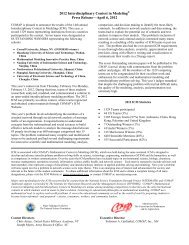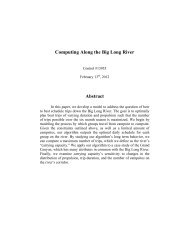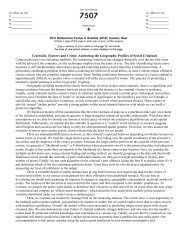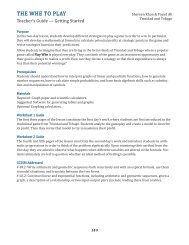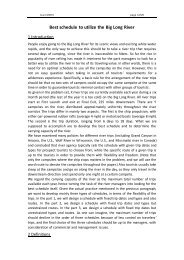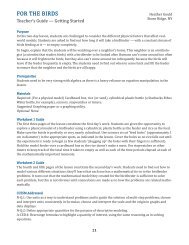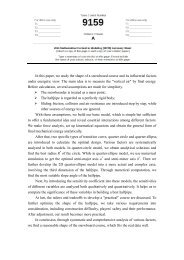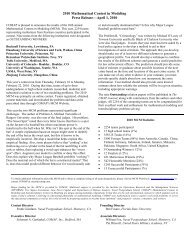You also want an ePaper? Increase the reach of your titles
YUMPU automatically turns print PDFs into web optimized ePapers that Google loves.
PII: S0025-326X01)00114-X<br />
Marine Pollution Bulletin Vol. 42, No. 12, pp. 1297±1300, 2001<br />
Ó 2001 Elsevier Science Ltd. All rights reserved<br />
Printed in <strong>Great</strong> Britain<br />
0025-326X/01 $ - see front matter<br />
A Comparison of Plastic and Plankton<br />
in the North Paci®c Central Gyre<br />
C. J. MOORE *, S. L. MOORE , M. K. LEECASTERà ,1 and S. B. WEISBERGà<br />
Algalita Marine Research Foundation, 345 Bay Shore Avenue, Long Beach, CA 90803, USA<br />
àSouthern California Coastal Water Research Project, 7171 Fenwick Lane, Westminster, CA 92683, USA<br />
<strong>The</strong> potential for ingestion of plastic particles by open<br />
ocean ®lter feeders was assessed by measuring the relative<br />
abundance and mass of neustonic plastic and zooplankton<br />
in surface waters under the central atmospheric highpressure<br />
cells of the North Paci®c <strong>Ocean</strong>. Neuston samples<br />
were collected at 11 random sites, using a manta<br />
trawl lined with 333 u mesh. <strong>The</strong> abundance and mass of<br />
neustonic plastic was the largest recorded anywhere in the<br />
Paci®c <strong>Ocean</strong> at 334 271 pieces km 2 and 5114 gkm 2 ,<br />
respectively. Plankton abundance was approximately ®ve<br />
times higher than that of plastic, but the mass of plastic<br />
was approximately six times that of plankton. <strong>The</strong> most<br />
frequently sampled types of identi®able plastic were thin<br />
®lms, polypropylene/mono®lament line and unidenti®ed<br />
plastic, most of which were miscellaneous fragments.<br />
Cumulatively, these three types accounted for 98% of the<br />
total number of plastic pieces. Ó 2001 Elsevier Science<br />
Ltd. All rights reserved.<br />
Keywords: North Paci®c central gyre; neuston; plastics;<br />
zooplankton; debris; pollution monitoring.<br />
Marine debris is more than an aestheticproblem, posing<br />
a danger to marine organisms through ingestion and<br />
entanglement Day, 1980; Balazs, 1985; Fowler, 1987;<br />
Ryan, 1987; Robards, 1993; Bjorndal et al., 1994; Laist,<br />
1997). <strong>The</strong> number of marine mammals that die each<br />
year due to ingestion and entanglement approaches<br />
100 000 in the North Paci®c <strong>Ocean</strong> alone Wallace,<br />
1985). Worldwide, 82 of 144 bird species examined<br />
contained small debris in their stomachs, and in many<br />
species the incidence of ingestion exceeds 80% of the<br />
individuals Ryan, 1990). In addition, a recent study has<br />
determined that plastic resin pellets accumulate toxic<br />
chemicals, such as PCBs, DDE, and nonylphenols, and<br />
may serve as a transport medium and source of toxins to<br />
marine organisms that ingest them Mato et al., 2001).<br />
Many studies have focused on the ingestion of small<br />
debris by birds because their stomach contents can be<br />
regurgitated by researchers in the ®eld without causing<br />
*Corresponding author.<br />
1 Present address: INEEL, Bechtel WBXT, Idaho, LLC, P.O. Box<br />
1625, Idaho Falls, ID 83415-3779, USA.<br />
harm to the animal. Less well studied are the e€ects of<br />
ingestible debris on ®sh, and no studies have been conducted<br />
on ®lter-feeding organisms, whose feeding<br />
mechanisms do not permit them to distinguish between<br />
debris and plankton. Moreover, no studies have compared<br />
the amount of neustonicdebris to that of plankton<br />
to assess the potential e€ects on ®lter feeders.<br />
Concerns about the e€ects of neustonic debris in the<br />
marine environment are greatest in oceanographic convergences<br />
and eddies, where debris fragments naturally<br />
accumulate Shaw and Mapes, 1979; Day, 1986; Day and<br />
Shaw, 1987). <strong>The</strong> North Paci®c central gyre, an area of<br />
high atmospheric pressure with a clockwise ocean current,<br />
is one such area of convergence that forces debris<br />
into a central area where winds and currents diminish.<br />
This study compares the abundance and mass of neustonicdebris<br />
with the amount of zooplankton in this area.<br />
Materials and Methods<br />
Eleven neuston samples were collected between August<br />
23 and 26, 1999, from an area near the central pressure<br />
cell of the North Paci®c sub tropical high Fig. 1).<br />
Sampling sites were located along two transects: a<br />
westerly transect from 35°45.8 0 N, 138°30.7 0 W to<br />
36°04.9 0 N, 142°04.6 0 W; and a southerly transect from<br />
36°04.9 0 N, 142°04.6 0 Wto34°40.0 0 N. Location along the<br />
transect and trawl duration were selected randomly.<br />
Samples were collected using a manta trawl with a<br />
rectangular opening of 0:9 0:15 m 2 , and a 3.5 m long,<br />
333 u net with a 30 10 cm 2 collecting bag. <strong>The</strong> net was<br />
towed at the surface outside of the e€ects of port wake<br />
from the stern of the vessel) at a nominal speed of<br />
1ms 1 ; actual speed varied between 0.5 and 1.5 m s 1 ,<br />
as measured with a B&G paddlewheel sensor. Each<br />
trawl was conducted for a random distance, ranging<br />
from 5 to 19 km. Sampling was conducted as the ship<br />
moved along the transect with an approximately even<br />
split of sampling between daylight and night-time hours.<br />
Estimates of plasticand plankton per square kilometer<br />
were obtained by using the width of the trawl net<br />
opening times the length of the trawl.<br />
Samples were ®xed in 5% formalin, then soaked in<br />
fresh water and transferred to 50% isopropyl alcohol.<br />
1297







